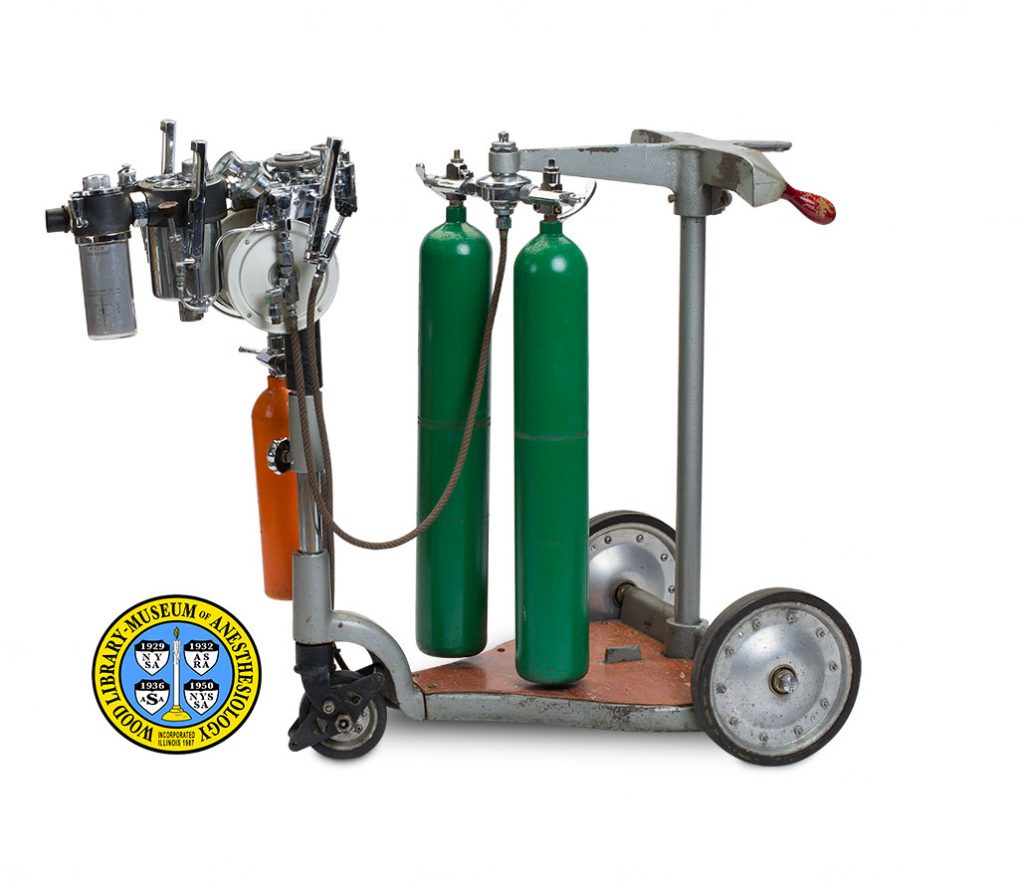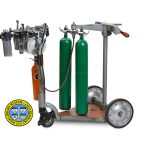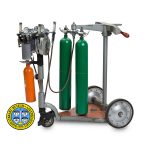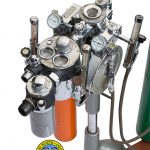McKesson Nargraf Model L
Elmer I. McKesson, M.D. (1881-1935) founded the McKesson Appliance Company to manufacture anesthesia equipment of his own design. The McKesson Nargraf machine, introduced in 1930, was made in several models and configurations. The Model L was introduced by 1935 and continued in production through 1962, when the company became a division of American Cryogenics, Inc. The example shown here has the standard or "Indicating" Nargraf machine head, rather than the more sophisticated "Recording" head. It could administer ether, oxygen, nitrous oxide and cyclopropane. It is mounted on a cart that could hold large cylinders of compressed gases.
The Nargraf was also the basis for some of McKesson's smaller machines, such as the Narmatic. All of these were intermittent flow (also called demand flow) machines. They relied on the patient's spontaneous respiration for the delivery of gases. This method was criticized in the 1970s as being inferior to intermittent positive pressure, a feature of more modern equipment. At that time McKesson's machines were still in wide use, but Dr. McKesson's death in 1935, and the company's continuing use of older technologies, may have helped lead to the demise of the company.
Catalog Record: McKesson Nargraf Model L McKesson Model L
Access Key: aqkt
Accession No.: 2012-01-20-2
Title: McKesson Nargraf model L / Elmer I. McKesson.
Corporate Author: McKesson Appliance Company.
Publisher: Toledo, Ohio : McKesson Appliance Company, [ca. 1935-1964].
Physical Description: 1 anesthesia machine : metals, glass, rubber, wood, Linoleum, paper ; 92 x 119.5 x 74 cm.
Subject: Anesthesia, Inhalation – instrumentation.
Subject: Anesthesia Machines.
Subject: Cyclopropane.
Subject: Ether, Ethyl.
Subject: Nitrous Oxide.
Subject: Oxygen.
Note Type: General
Notes: The first year in the date range is that of the earliest publication in which it was found by the cataloger. The latest of the manufacturer’s publications in which it was found is dated 1962. The next dated manufacturer’s publication, a 1964 catalog, does not contain any Nargraf models.
Married to a cyclopropane cylinder from the parts collection, for purposes of photography.
Note Type: Citation
Notes: Allen GD. The enigma of air dilution. Anesthesia Progress. May-June, 1970;17(3):52-54.
Note Type: Citation
Notes: Allen GD. Dental Anesthesia and Analgesia. Baltimore: Williams & Wilkins Company, 1972:72-74.
Note Type: Citation
Notes: Dorsch JA, Dorsch SE. Understanding Anesthesia Equipment: Construction, Care and Complications. Baltimore: Williams & Wilkins, 1975:72-77.
Note Type: Citation
Notes: Gauert WB, Hustead RF. Differences in metered and measured oxygen concentration during nitrous oxide analgesia. Anesth Analg. July, 1968;47(4):441-445.
Note Type: Citation
Notes: McKesson Company File. Archives. Located at: Wood Library-Museum of Anesthesiology, Schaumburg, Illinois.
Note Type: Physical Description
Notes: One anesthesia machine; The short physical description gives the width with the machine head turned perpendicular to the cart; When the machine head is aligned with the cart, the width is that of the wheeled base (63.5 centimeters); Consists of machine head, carbon dioxide absorber and ether vaporizer mounted on a three-wheeled cart;
The cart has a roughly triangular metal frame with one rubber wheel in front that is mounted on a swiveling caster, and two larger rubber wheels in back that are mounted on an axle. The floor of the cart appears to be made of wood covered by Linoleum; The floor can hold two large cylinders of compressed gas;
The frame holds one pole in front, mounted over the front wheel, and one pole in back, mounted over the rear wheels; The machine head with its connected components is attached to a black tube or sleeve that fits over the top of this pole; This tube can be tightened or loosened by turning a knob; The rear pole is topped by a T-shaped bar; The long arm of this bar holds two wooden handles; These handles are angled downward; The shorter arm is perpendicular to the first; This arm holds a regulator head that itself holds two cylinder yokes; This regulator head is marked: “McKESSON APPLIANCE CO. [new line] TOLEDO, O., U.S.A.”.
The machine head holds several dials and other controls above a pair of squat cylinders; The top of the machine head is stamped with the serial number: “J 10386”; This number is stamped behind and to the left of the dials;
The two squat cylinders are mounted vertically, one on either side of the pole; Mounted on top of each cylinder is a pressure gauge; These gauges are identically marked: “LOW, OPERATING RANGE, HIGH [new line] McKESSON APPLIANCE CO. [new line] TOLEDO, OHIO, U.S.A. [new line] [Maltese cross logo:] U. S. GAUGE CO. N.Y.”;
That cylinder to the right of the front pole is marked “O2”; One end of a textile hose is attached to this cylinder; The other end of this hose is attached to the regulator head that is supported by the rear pole; That cylinder to the left of the front pole is marked “N2O”; One end of a textile hose is connected to this cylinder, while the other end is loose;
[Continued] A large disc-shaped dial on top of the head is marked in concentric rings; The exterior ring reads: “PAT NOS. RE-17512 – 1,632,449 – 1,667,255 OTHER PATS. PEND.”; The next ring reads: “MCKESSON NARGRAF” in cursive script; The next ring reads: “McKESSON APPLIANCE CO., TOLEDO, OHIO, U.S.A.”; the next ring reads: “OXYGEN PERCENT [new line] 100, 75, 50, 25, 0”; The innermost ring reads: “MODEL L (new line) USE SMALL DIAL”;
A smaller dial is mounted above and to the rear of this large dial, so that it partially obscures the large dial; The small dial is marked: “OXYGEN PERCENT [new line] 0, 5, 10, 15, 20, 25, 30, 35, 40, 45”; Another small dial is mounted immediately in front of the large dial; This small dial is marked: “PRESSURE mm [new line] 0, 5, 10,20, 30, 40”; A knob is mounted behind this dial; This knob is marked: “ON, OFF”;
An oxygen flush button is mounted to the right of the large dial; This button is marked: “DIRECT OXYGEN [new line] PUSH BUTTON”; To the right of the oxygen flush button, a helium flowmeter is mounted on the tube; Behind the glass window of this flowmeter a paper label reads, from top to bottom: “HE [new line] LITERS [new line] Per Minute [new line] 1.0, .8, .6, .4, .2”; One end of a textile hose is attached to the bottom of this flowmeter by a metal connector, while the other end is loose;
A carbon dioxide absorber is mounted on the front of the machine head; The absorber is marked: “McKESSON APPLIANCE CO. [new line] MODEL 620 [new line] SER NO 1187”; A large dial on top of the absorber is marked: “OFF, 0, 1, 2, 3, ON”; A small dial to the left of this large dial is marked “HOURS USED [new line] 1, 2, 3, 4, 5, 6”;
A cyclopropane flowmeter is mounted to the left of the absorber; Behind the glass window of this flowmeter a paper label reads, from top to bottom: “LITERS [new line] Per Minute [new line] C3H6 [new line] 1.0, .8, .6, .4, .2”; An oxygen flowmeter is mounted to the right of the absorber; Behind the glass window of this flowmeter a paper label reads, from top to bottom: “LITERS [new line] Per Minute [new line] O2 [new line] 1.0, .8, .6, .4, .2”;
An ether vaporizer is mounted on the front of the absorber; A dial at the top of the vaporizer is marked: “McKESSON APPLIANCE CO., TOLEDO, OHIO, U.S.A. [new line] ETHER VAPORIZER MODEL 965 SER NO. X4277 [new line] FILL [new line] OFF [new line] 1, 2, 3, 4, 5, 6, 7, NO”; There is a funnel-shaped filling port to the right of the dial; The glass vaporizer bottle is painted gray; All of the bottle’s markings were made by a stencil when it was painted, so that they appear on the clear glass in the midst of the gray surface; From top to bottom, these are: “McKESSON [new line] ETHER JAR H-1597 [new line] DO NOT FILL ABOVE THIS LINE”; A vertical line appears below this; To the left of the vertical line the glass is marked, from top to bottom: “CC, 160, 120, 80, 40”; To the right of the vertical line the glass is marked, from top to bottom: “OZ. BY WEIGHT, 4, 3, 2, 1”.
Note Type: Reproduction
Notes: Photographed by Mr. Steve Donisch, June 21, 2017.
Note Type: Historical
Notes: Around 1910, Elmer I. McKesson, M.D. (1881-1935) founded the Toledo Technical Appliance Co. to manufacture anesthesia equipment of his own design. In 1930, the company name was changed to the McKesson Appliance Co. The year 1930 also saw the introduction of McKesson’s new standard and recording Nargraf machines. The standard machine was called the Indicating Nargraf. The Recording Nargraf could produce a paper record of patient vital signs during inhalation anesthesia. By 1962 the company had become a division of American Cryogenics, Inc. By 1975, McKesson had become a division of Narco Medical Co.
McKesson Nargraf models J, L and N were available with either an indicating or a recording machine head. This family of machines was made in configurations for two, three or four gases. They could be mounted on various stands, including a three-wheeled cart that could hold large cylinders of compressed gases. The Nargraf was also the basis for some of McKesson’s smaller machines, such as the Narmatic.
In the 1960s, disenchantment with intravenous analgesics led to a growing use among dentists of inhalation agents for analgesia (pain relief). But various studies raised concerns about the accuracy of some gas analgesia machines. The Nargraf and Narmatic were intermittent flow (also called demand flow) machines. They relied on the patient’s spontaneous respiration for the delivery of gases. This method was criticized in the 1970s as being inferior to the delivery of gases through intermittent positive pressure, which more modern equipment could do. At that time McKesson’s machines were still in wide use, but McKesson’s preference for older technologies may have helped lead to the demise of the company.
The cataloged object is a Model L with a standard Nargraf machine head, and is mounted on a cart. It could administer ether, oxygen, nitrous oxide and cyclopropane. The latter two gases could not be administered simultaneously. The model L was introduced in 1935, and continued in production through 1962, when the company changed hands.
Note Type: Exhibition
Notes: Selected for the WLM website.




